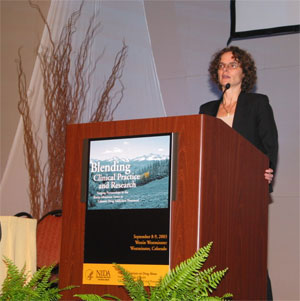September's 2-day NIDA conference, "Blending Clinical Practice and Research: Forging Partnerships in the Rocky Mountain States to Enhance Drug Abuse Treatment," drew an overflow crowd of 680 drug abuse researchers, administrators, and treatment providers to Westminster, Colorado. This was the third in the conference series established by NIDA to help narrow the gap between clinical practice and clinical research.
 NIDA Director Nora D. Volkow, M.D., presented the keynote address to nearly 700 participants at the 2003 Blending Conference.
NIDA Director Nora D. Volkow, M.D., presented the keynote address to nearly 700 participants at the 2003 Blending Conference."Blending is NIDA's short name for some of its most important work," explained NIDA Director Nora D. Volkow, M.D. "By blending, we mean the integrated research-practice partnership so necessary to achieve our full potential and relieve the suffering and waste of human life caused by drug abuse and addiction."
Conference co-sponsors included NIDA and the Rocky Mountain Clinical Trials Network (CTN) Node, one of 17 regional research and training centers within NIDA's nationwide CTN system. CTN, now in its fifth year, was developed to test the effectiveness of new and improved interventions in community-based treatment settings with diverse populations. The CTN has completed five clinical studies, and 21 other studies are underway or in development. Other key conference partners were the University of Colorado Health Sciences Center, home of the Rocky Mountain CTN node; the Colorado State Office of Alcoholism and Substance Abuse Services; the Alcoholism and Substance Abuse Providers of Colorado; the Mountain West Addiction Technology Transfer Center; and Signal Behavioral Health, Inc., the largest managed services organization for publicly funded treatment in Colorado.
Twelve topical workshops facilitated research-practice partnerships by highlighting research findings and implications, as well as considerations for putting research into practice and for future research. Each workshop presented critical issues and opportunities facing the drug abuse treatment and research communities, including assessment and treatment of psychiatric comorbidity, new brain research on craving and decision making, and treatment of opioid dependence with buprenorphine/Nalaxone combination tablets. Issues specific to Colorado were also on the agenda, including blending research and practice in Native American populations and ruralizing urban treatment. At the conclusion of the conference, clinical skills training workshops were held on evidence-based treatment approaches.
In her keynote address, Dr. Volkow drew on her dual clinical and research backgrounds in discussing progress in integrating drug abuse research into clinical practice. The gap between research and practice exists in every medical field, she noted, but closing that gap is imperative. "Knowledge is not a luxury," she commented. "Science that is not used is useless." Dr. Volkow reviewed recent scientific investigations that are enhancing our understanding of drug abuse and addiction and providing new treatment options through painstaking study of the workings of genes, protein expression, neurological circuitry, human behavior, and social networks. "Understanding drug abuse and addiction requires a systems approach . . . and treatment requires a multipronged approach," she said.
Although advances in science are leading to improved treatment options, Dr. Volkow observed, much more work is needed to ensure that they are used in community treatment settings. Toward that end, she said, NIDA will be increasing funding for research on translating research findings into clinical practice and considering how the CTN might be helpful in this respect without detracting from its primary mission.
In his plenary address, Thomas J. Crowley, M.D., University of Colorado School of Medicine, reviewed the relationship between research and practice based on his 40-year career. Through the years, science and practice have partnered in "an intimate relationship" that requires both following and leading, he noted. As a medical student, Dr. Crowley was taught that alcohol and drug use was evidence of moral deterioration. He urged participants not to forget that this position changed because of laboratory results--evidence that drugs of abuse produced drug-seeking in animals. Science and practice have each advanced the other, Dr. Crowley observed, and will continue to do so. Likewise, advances in the lab and the clinic continue to impact the social context of funding and treatment. "As scientists, clinicians, and administrators--we all walk the same journey and we are each part of a social movement."
T. Ron Jackson, M.S.W., executive director of Evergeen Treatment Services in Seattle, Washington, delivered the inaugural Eileen Pencer Lecture in honor of the dedicated and talented CTN leader and administrator of New York's Lower Eastside Service Center who died this year. "Eileen wanted us to keep the research real, never letting us forget that the patient is CTN's target," Mr. Jackson recalled. He urged treatment providers to incorporate research results into their own practices, while cultivating a research mindset as part of their professional development. "We need to think of research as a systematic, disciplined way of listening to our patients."
Closing remarks by clinician and researcher Paula Riggs, M.D., Principal Investigator of the Rocky Mountain CTN addressed the future of research-practice integration. She observed that the CTN's hard work and concrete accomplishments are reasons for optimism, as are the week's events. "The hope of all of us who worked on this year's program," said Dr. Riggs, "is that this conference will create a legacy of initiatives for blending research and practice for years to come."
